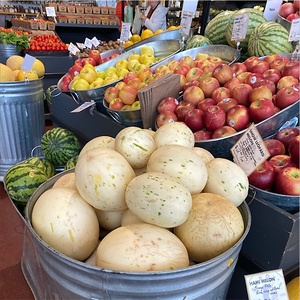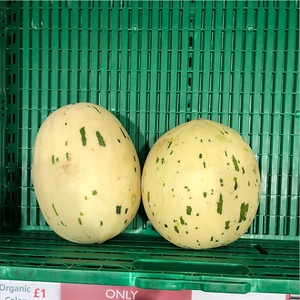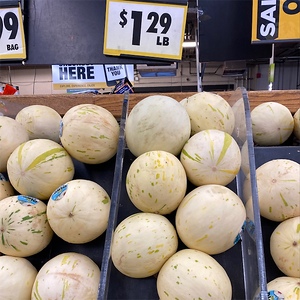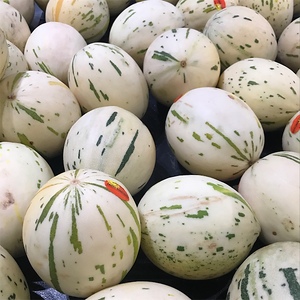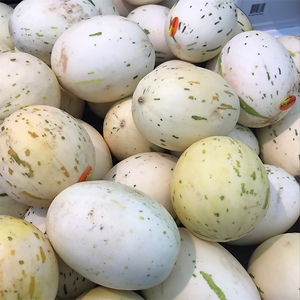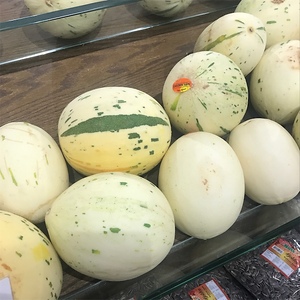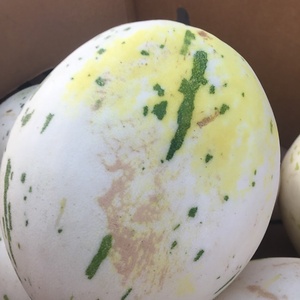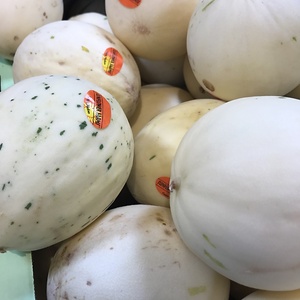

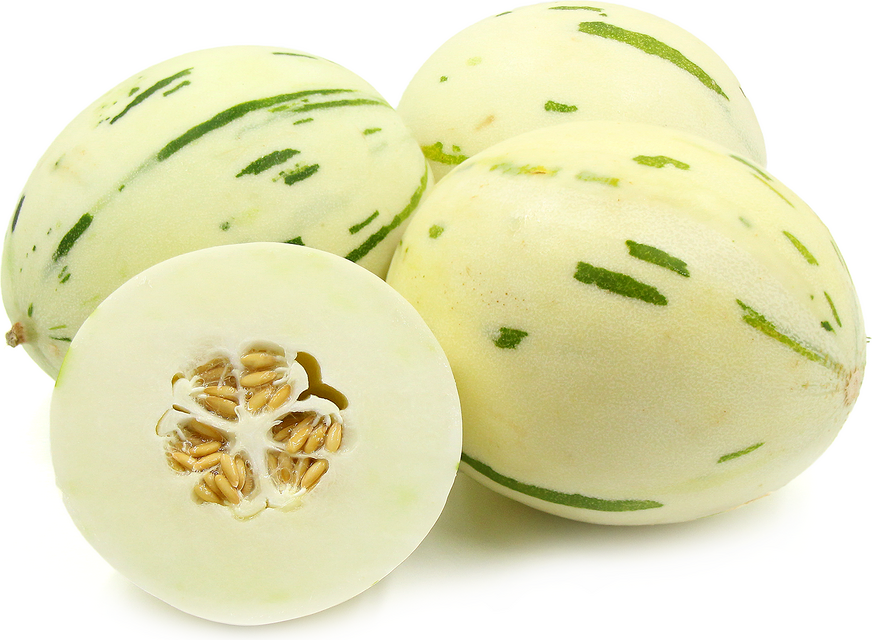
Ivory Gaya Melons
Estimated Inventory, lb : 0
Description/Taste
Ivory Gaya melons are a small-sized varietal with a round to oblong shape. The rind is thin, smooth, tough, and hard with an ivory base hue, covered in light to dark green variegated streaks and speckles. Underneath the surface, the flesh is white, dense, and thick, encasing a small central cavity filled with white fibers and many oval, tan seeds. The flesh has a firm, crisp consistency closer to the skin and develops a softer, juicier flavor near the seeds. Ivory Gaya melons will slightly give around the blossom end when ripe and emit a subtle, sweet, and faintly musky aroma. The flesh has a very mild and refreshing flavor with floral, pear, cucumber, and honey nuances.
Seasons/Availability
Ivory Gaya melons are generally harvested in the late spring through summer. The melons are grown in both the northern and southern hemispheres, providing year-round or an extended availability in some commercial markets.
Current Facts
Ivory Gaya melons, botanically classified as Cucumis melo var. inodorus, are a specialty hybrid variety belonging to the Cucurbitaceae family. The unusually colored muskmelon is a boutique melon commercially cultivated in limited quantities. The variety is highly favored for its speckled appearance, semi-firm, crisp flesh, and light flavoring, primarily consumed fresh in sweet and savory preparations. Ivory Gaya melons are also known as Snowball melons, Snow Leopard melons, Gaya melons, Ghost melons, Dinosaur melons, and is often referred to as an "icebox" melon, a small variety that easily fits in a refrigerator’s crisper drawer. The relatively new cultivar is grown in regions worldwide and has a long shelf life, allowing the melons to be exported to retail markets outside of the typical melon season.
Nutritional Value
Ivory Gaya melons are a source of potassium to balance fluid levels within the body and vitamin C to strengthen the immune system, boost collagen production, and reduce inflammation. The melons also contain magnesium to maintain optimal nerve functioning, folate to produce red blood cells, and antioxidants to protect the cells against free radical damage.
Applications
Ivory Gaya melons have a subtly sweet and floral flavor well suited for fresh preparations. The melon has a crisp consistency, allowing it to be sliced into thin pieces and tossed into green salads, chopped into salsa and herbal dips, or mixed into fruit bowls. Ivory Gaya melons can also be sprinkled with lemon or lime juice to enhance the flavor for fresh consumption, wrapped in salty cured meats as an appetizer, or blended into smoothies, juices, and cocktails. The melon’s small size allows it to be used as an individual serving, halved and filled with yogurt, granola, and honey, or it can be sliced and infused into water for a faint vegetal flavoring. The fruits can also be used as a base for cold soups or sauces, balled and drizzled in a honey-ginger syrup, or piled as a fresh topping over crepes, pancakes, oatmeal, ice cream, and sorbet. Ivory Gaya melons pair well with other fruits such as strawberries, blueberries, citrus, and kiwi, herbs including cilantro, mint, and basil, salty meats such as salami and prosciutto, cheeses including parmesan, feta, and mozzarella, balsamic vinegar, tomatoes, cucumbers, and olives. Whole Ivory Gaya melons will keep at room temperature until ripe. Once cut, the sliced pieces of flesh should be stored in an airtight container for up to three days.
Ethnic/Cultural Info
In Great Britain, Ivory Gaya melons are marketed through Tesco, a grocery and general merchandise retailer. The melons are imported from Brazil and are sold in British markets throughout the winter season under the name Snowball melon. The height of melon season traditionally appears in the summer, but by offering refreshing fruits during the typically stark winter season, the melon market has quickly expanded into a booming sector. In 2019, it was reported that melons were the fastest-growing fruit category within Great Britain, and experts were attributing the increase to an expanding children’s market. Parents are turning to melons as a nutritious alternative to candy and are serving melons as a fresh dessert. Ivory Gaya melons are also served as holiday appetizers, balled and skewered as bite-sized treats, sliced and tossed into green salads, drizzled in yogurt, or blended into sorbet. Beyond culinary dishes, some British dinner hosts have created recipes where the melon is hollowed and filled with a festive fruit punch, creating a whimsical serving container.
Geography/History
Ivory Gaya melons are native to East Asia and have been cultivated in Korea and Japan since the early 2000s. The melons quickly achieved commercial success for their delicate flavoring, and in 2002, the variety was selected for export to Hong Kong and Taiwan. Ivory Gaya melons were later introduced to China and were sent to North and South America for expanded cultivation. The melons were released to commercial markets in the United Kingdom in 2015 and were heavily promoted as a specialty winter variety. Today Ivory Gaya melons are grown in Asia, Spain, Australia, Morocco, Senegal, Brazil, Mexico, and the United States. The variety is challenging to find and is generally sold through distributors, farmer’s markets, and Asian grocers.
Recipe Ideas
Recipes that include Ivory Gaya Melons. One



